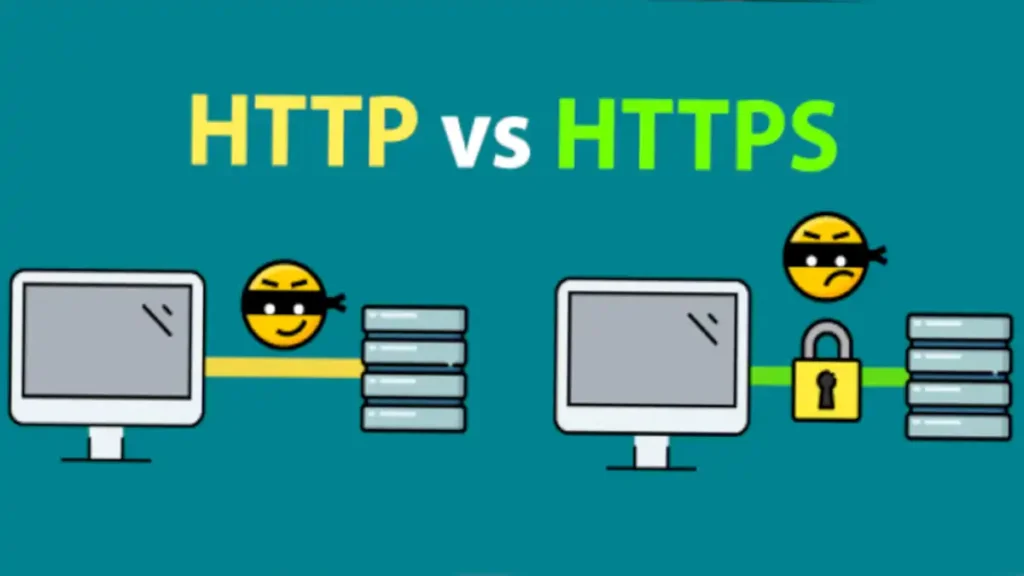In the sprawling digital cityscape, where bytes and bits form the architecture of our online existence, the difference between HTTP and HTTPS stands as a pivotal distinction on two main thoroughfares that dominate the landscape.
To the untrained eye, these protocols might seem almost identical, their names separated by just a mere ‘S.’ However, when one delves deeper into the difference between HTTP and HTTPS, a narrative unfolds that is rich with intrigue, security, and the ongoing tussle between innovation and vulnerability. So, prepare for an enlightening voyage, dear reader, as we traverse the highways of cyberspace, discerning the nuances between these twin protocols.

HTTP: The Open Boulevard
The Hyper Text Transfer Protocol, fondly known as HTTP, is akin to an open boulevard where information flows freely. When you visit a website, your browser requests data, and the server responds—this exchange happens over HTTP. But there’s a caveat. Imagine strolling in a bustling market, openly discussing personal matters; any passerby could eavesdrop, gaining insights into your life.
Technically speaking, HTTP is stateless, meaning each request from a client to a server is treated as a standalone, with no memory of prior interactions. It’s efficient, but it’s also vulnerable. Data, be it login credentials or personal messages, travels unencrypted. This makes it susceptible to “man-in-the-middle” attacks, where malicious entities intercept and potentially alter the communication.
HTTPS: The Fortified Expressway
Then comes the Hyper Text Transfer Protocol Secure (HTTPS), the fortified expressway of the internet. This isn’t just a road; it’s a road within a secure tunnel. The ‘S’ in HTTPS isn’t just a letter; it’s a badge of honor, representing the robust security layer added to the protocol, achieved primarily through TLS (Transport Layer Security) or its predecessor, SSL (Secure Sockets Layer).
When data traverses the HTTPS highway, it’s enveloped in a protective cloak of encryption. This cryptographic wrapping ensures that even if malevolent forces intercept the data, deciphering its contents becomes an exercise in futility. Moreover, HTTPS offers assurance. When you see the padlock icon in your browser’s address bar, it’s a testament that the website you’re interacting with has been verified and is genuine. No imposters here!
The Crossroads: HTTP vs. HTTPS
At their essence:
HTTP is like speaking openly in a room, clear and audible to everyone present.
HTTPS, on the other hand, is like having that conversation in a soundproof room with a trusted friend, using a secret language only the two of you comprehend.
Beyond the obvious security advantages, HTTPS has other merits. With the digital populace becoming more privacy-conscious, HTTPS is increasingly seen as a marker of trustworthiness. Search engines, too, have joined the chorus, with giants like Google giving a nod to HTTPS sites in their rankings.
Advantages of Switching to HTTPS
The HTTPS Renaissance: Why Make the Shift?
As we’ve traversed the distinction between HTTP and HTTPS, a discerning reader might pose the question: “Why should I, as a website owner or user, prioritize HTTPS?” The answer lies not just in its cryptographic shield but in a myriad of tangible benefits that cater to the modern digital ecosystem:
Boosted Trust & Credibility
The padlock icon and ‘HTTPS’ prefix in the browser address bar act as digital endorsements. They signal to visitors that their data is secure, fostering an environment of trust and enhancing website credibility.
SEO Advantage
Search engines have sung praises for HTTPS. Giants like Google have incorporated HTTPS as a ranking signal. A secure site, thus, gets a preferential nod in search rankings.
Data Integrity
HTTPS ensures that the data traveling between the browser and the server remains untouched and unaltered. This integrity ensures that no malicious third-party scripts or ads can be injected into your webpage content.
Enhanced Privacy
Beyond mere encryption, HTTPS guarantees that the URLs of the sites you visit remain hidden, ensuring that browsing sessions are private and safe from potential snoopers.
Future-Proofing
With the onset of HTTP/3, the next iteration of the protocol, HTTPS is set to be an integral component. Adopting it now prepares websites for the innovations on the horizon.
Increased Conversion Rates
Numerous studies indicate a correlation between HTTPS and increased conversion rates. Visitors are more likely to make purchases, sign up, or share information on a site they deem secure.
In essence, while HTTP served the foundational years of the web dutifully, HTTPS is the harbinger of a secure, trustworthy, and advanced internet. By embracing it, businesses and users alike position themselves at the vanguard of a safer and more credible digital epoch.
Conclusion
The tale of the difference between HTTP and HTTPS is more than a narrative of technological progression; it’s a reflection of the web’s maturation. As our digital interactions evolved from casual browsing to encompassing every facet of our lives—shopping, banking, socializing—the need for a more secure protocol became evident. In this continuum, while HTTP laid the foundation, HTTPS fortified the structure, ensuring the sanctity and security of our digital endeavors.